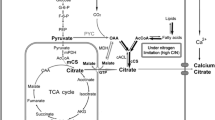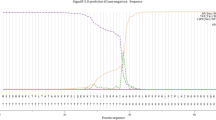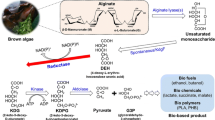Abstract
In this study, phosphoenolpyruvate carboxylase (PEPC) derived from Oceanimonas smirnovii (OS) was expressed as a soluble protein in Escherichia coli BL21(DE3). We isolated OS-PEPC (a recombinant PEPC protein) by his-tag purification. The purified protein showed a single band upon analysis with SDS-PAGE, and it had an apparent molecular mass of 98 kDa. Pufied OS-PEPC showed a specific activity value of 21.8 ± 0.495 U/mg protein. Especially, OS-PEPC showed the enzymatic activity between 40 and 50 °C. It maintained enzymatic activity in basic pH conditions (pH value, 9–10). We also measured OS-PEPC PEP and HCO3 − saturation kinetics and confirmed the effect of divalent cation on OS-PEPC activity.



Similar content being viewed by others
References
Sam, H. (2007). Carbon dioxide capture and geological storage. Philosophical Transactions of the Royal Society A, 365, 1095–1107.
Lee, S. W., Park, S. B., Jeong, S. K., Lim, K. S., Lee, S. H., & Trachtenberg, M. C. (2010). On carbon dioxide storage based on biomineralization strategies. Micron, 41, 273–282.
Kwon, Y. D., Kwon, O. H., Lee, H. S., & Kim, P. (2007). The effect of NADP-dependent malic enzyme expression and anaerobic C4 metabolism in Escherichia coli compared with other anaplerotic enzymes. Journal of Applied Microbiology, 103, 2340–2345.
Hatch, M. D., & Slack, C. R. (1970). Photosynthetic CO2-fixation pathways. Annual Review of Plant Physiology, 21, 141–162.
Chang, K. S., Jeon, H. C., Gu, M. B., Pack, S. P., & Jin, E. S. (2013). Conversion of carbon dioxide to oxaloacetate using integrated carbonic anhydrase and phosphoenolpyruvate carboxylase. Bioprocess and Biosystems Engineering, 36, 1923–1928.
Ki, M. R., Min, K. H., Kanth, B. S., Lee, J. W., & Pack, S. P. (2013). Expression, reconstruction and characterization of codon-optimized carbonic anhydrase from Hahella chejuensis for CO2 sequestration application. Bioprocess and Biosystems Engineering, 36, 375–381.
Sánchez, R., & Francisco, J. C. (2003). Identification and expression analysis of a gene encoding a bacterial-type phosphoenolpyruvate carboxylase from Arabidopsis and rice. Plant Physiology, 132, 949–957.
Wang, D., Li, Q., Li, W. L., Xing, J. M., & Su, Z. Q. (2009). Improvement of succinate production by overexpression of a cyanobacterial carbonic anhydrase in Escherichia coli Enzym. Microbial. Technol., 45, 491–497.
Park, S. H., Hong, S. H., Pack, S. P., & Lee, J. W. (2014). High activity and stability of codon-optimized phosphoenolpyruvate carboxylase from Photobacterium profundum SS9 at low temperatures and its application for in vitro production of oxaloacetate. Bioprocess and Biosystems Engineering, 37, 331–335.
Park, S. H., Pack, S. P., & Lee, J. W. (2012). Expression of codon-optmized phosphoenolpyruvate carboxylase gene from Glaciecola sp. HTCC2999 in Escherichia coli and its application for C4. Applied Biochemistry and Biotechnology, 167, 1845–1853.
Ivanova, E. P., Onyshchenko, O. M., Christen, R., Zhukova, N. V., Lysenko, A. M., Shevchenko, L. S., Buljan, V., Hambly, B., & Kiprianova, E. A. (2005). Oceanimonas smirnovii sp. nov., a novel organism isolated from the Black Sea. Applied Microbiology, 28, 131–136.
Michael, J. W., Daniel, H. D., Elaine, A. B., & Peter, O. O. (1996). Optimization of heterologous protein production in Escherichia coli. Current Opinion in Biotechnology, 7, 494–499.
Gerhard, H., & Savvas, C. M. (1998). Strategies for optimizing heterologous protein expression in Escherichia coli. Trends in Biotechnology, 16, 54–60.
Kohji, U., & Tatsuo, S. (1976). Purification and characterization of phosphoenolpyruvate carboxylase from maize leaves. Plant Physiology, 57, 906–910.
Rivoal, J., William, C. P., & David, H. T. (1998). Purification and characterization of high- and low-molecular-mass isoforms of phosphoenolpyruvate carboxylase from Chlamydomonas reinhardtii. The Biochemical Journal, 331, 201–209.
Kai, Y., Matsumura, H., Inoue, T., Terada, K., Nagara, Y., Yoshinaga, T., Kihara, A., Tsumura, K., & Izui, K. (1999). Three-dimensional structure of phosphoenolpyruvate carboxylase: a proposed mechanism for allosteric inhibition. Proceedings of the National Academy of Sciences, 96, 823–828.
Acknowledgments
This research was supported by the Basic Core Technology Development Program for the Oceans and the Polar Regions of the National Research Foundation (NRF) funded by the Ministry of Science, ICT and Future Planning (NRF-2010-0020501).
Author information
Authors and Affiliations
Corresponding authors
Rights and permissions
About this article
Cite this article
Park, S., Lee, W., Kim, H. et al. Characterization of Phosphoenolpyruvate Carboxylase from Oceanimonas smirnovii in Escherichia coli . Appl Biochem Biotechnol 177, 217–225 (2015). https://doi.org/10.1007/s12010-015-1739-3
Received:
Accepted:
Published:
Issue Date:
DOI: https://doi.org/10.1007/s12010-015-1739-3




